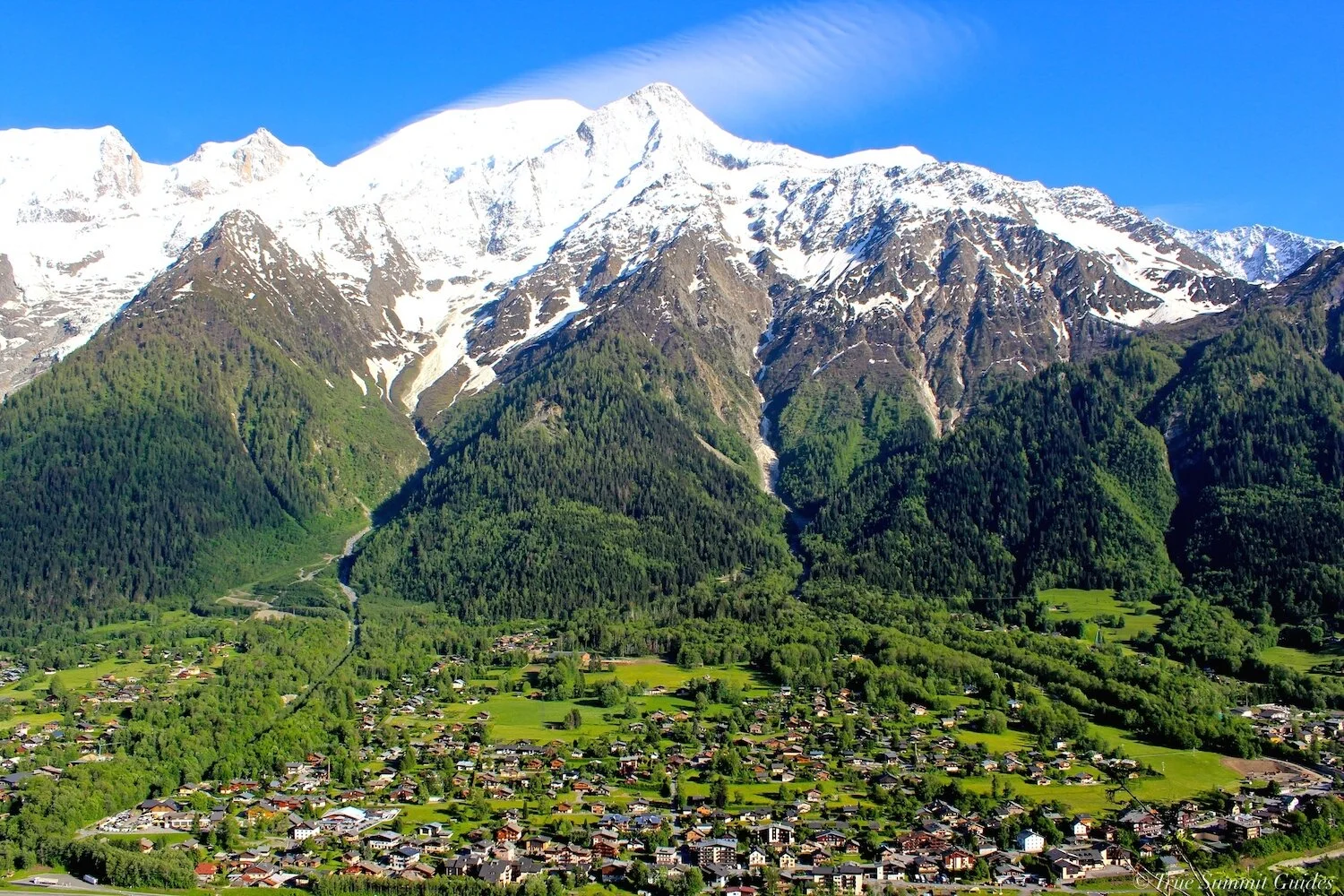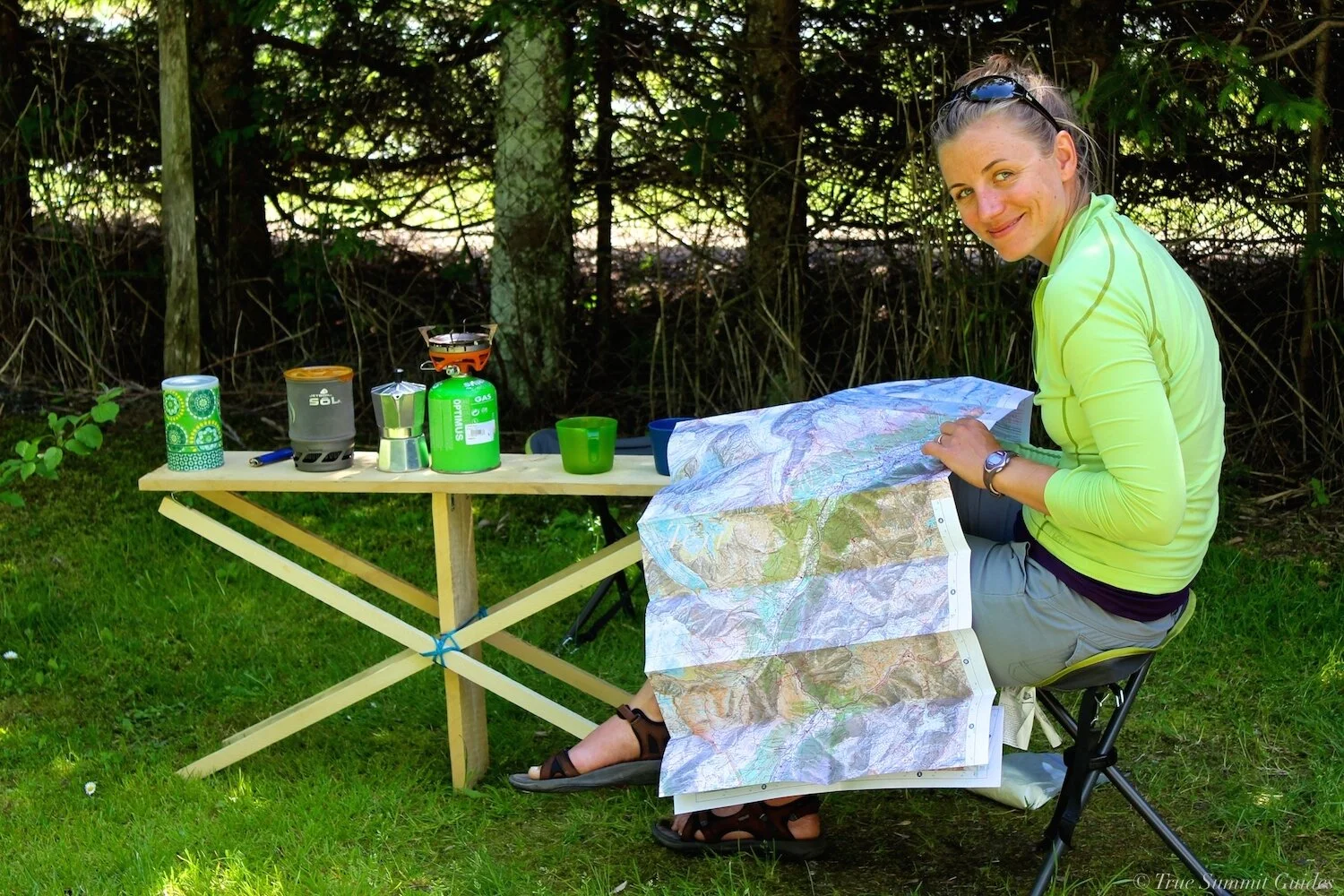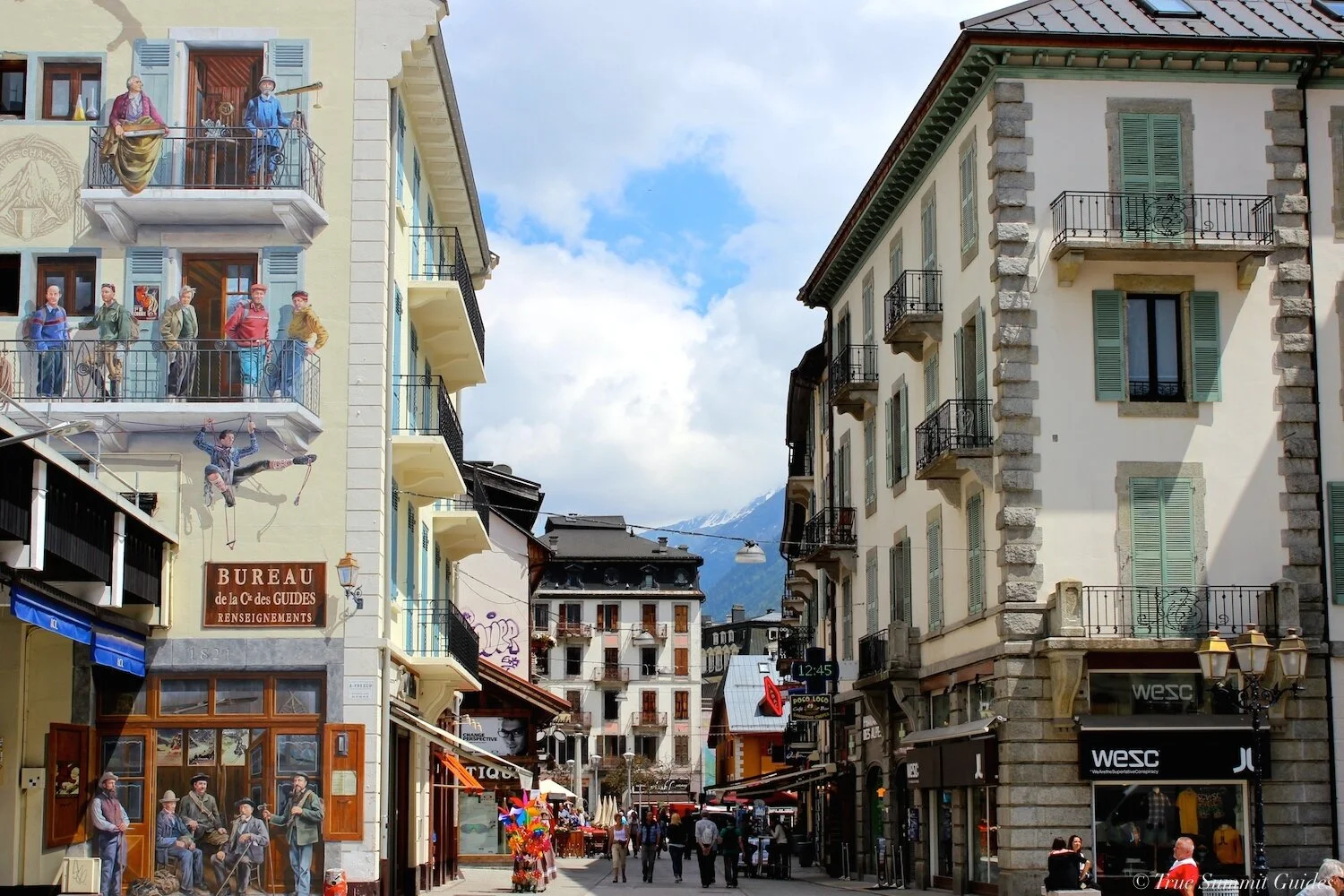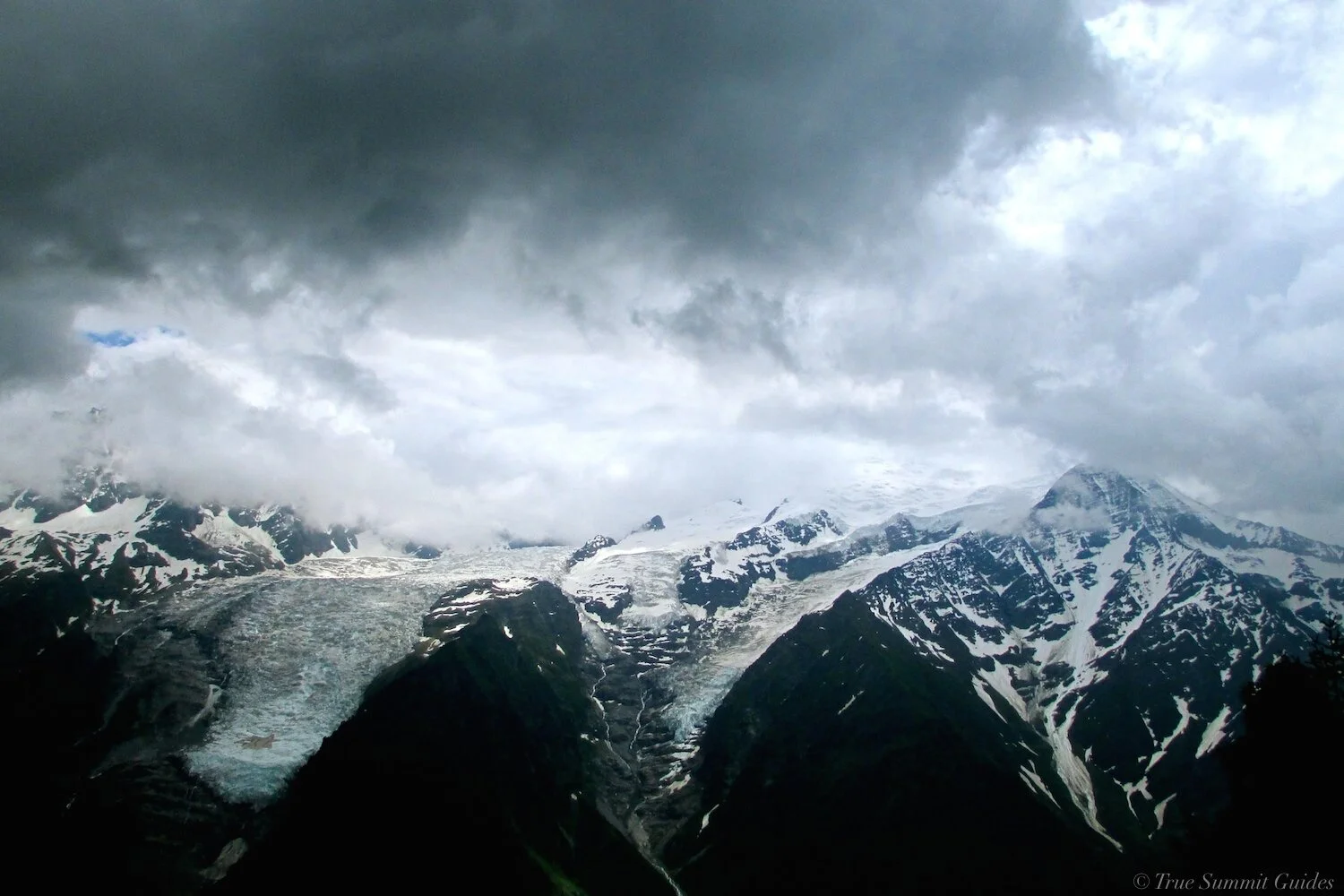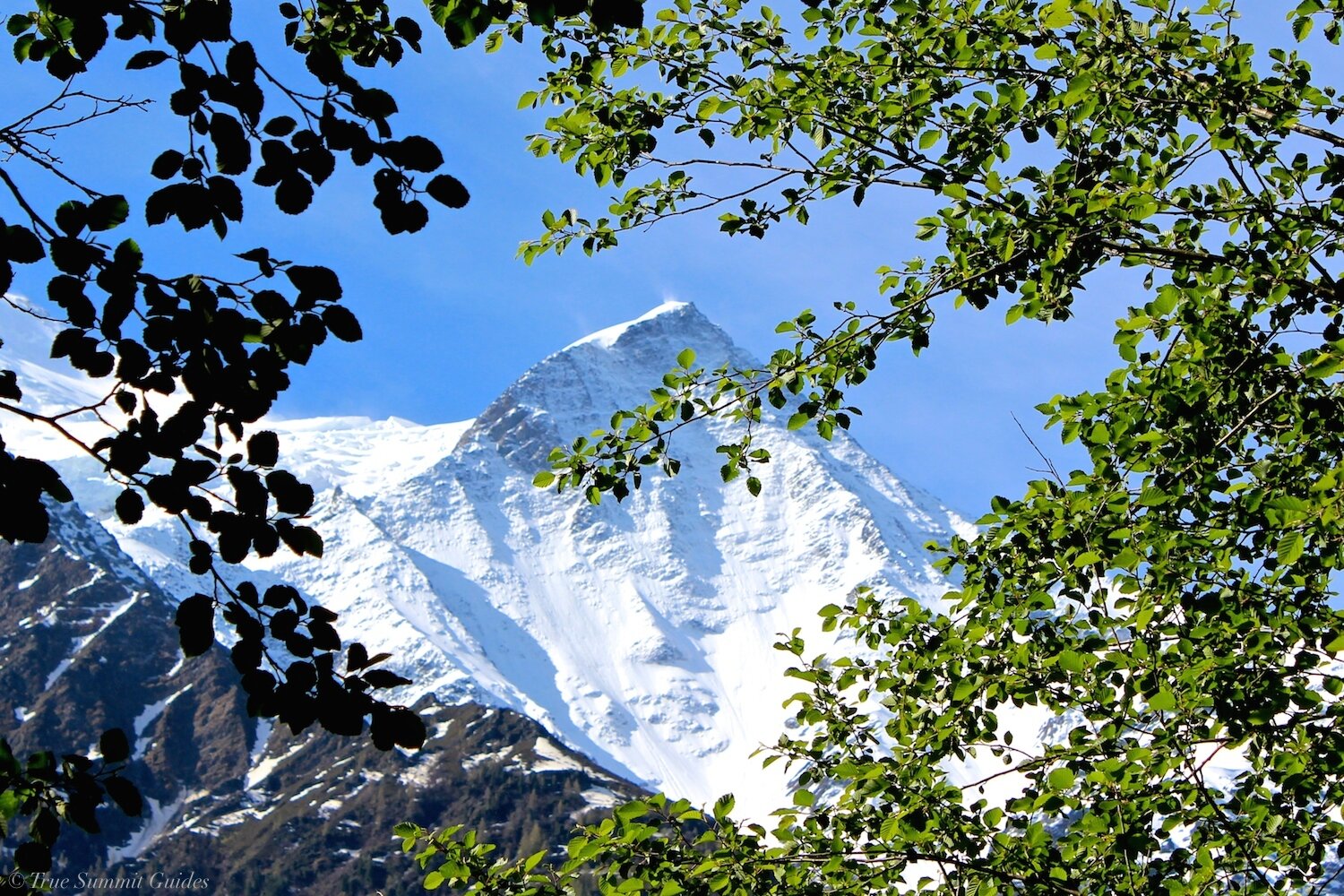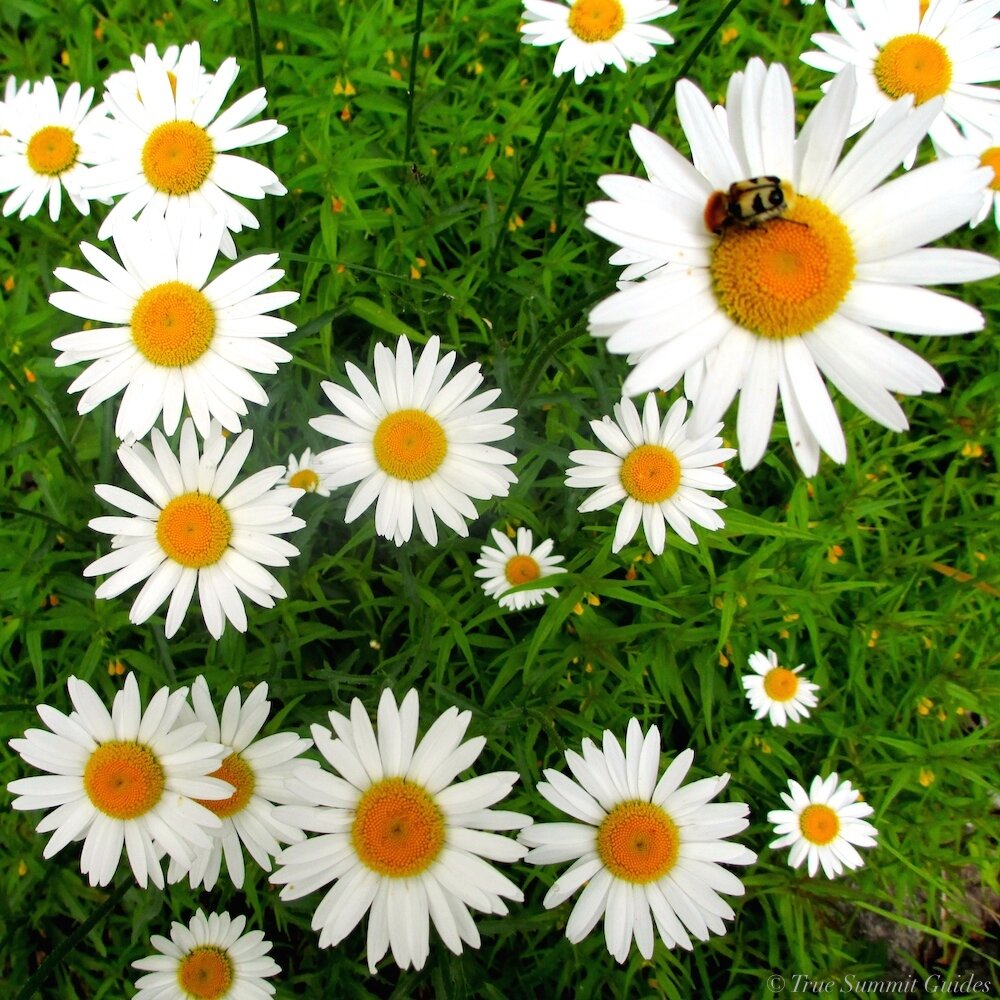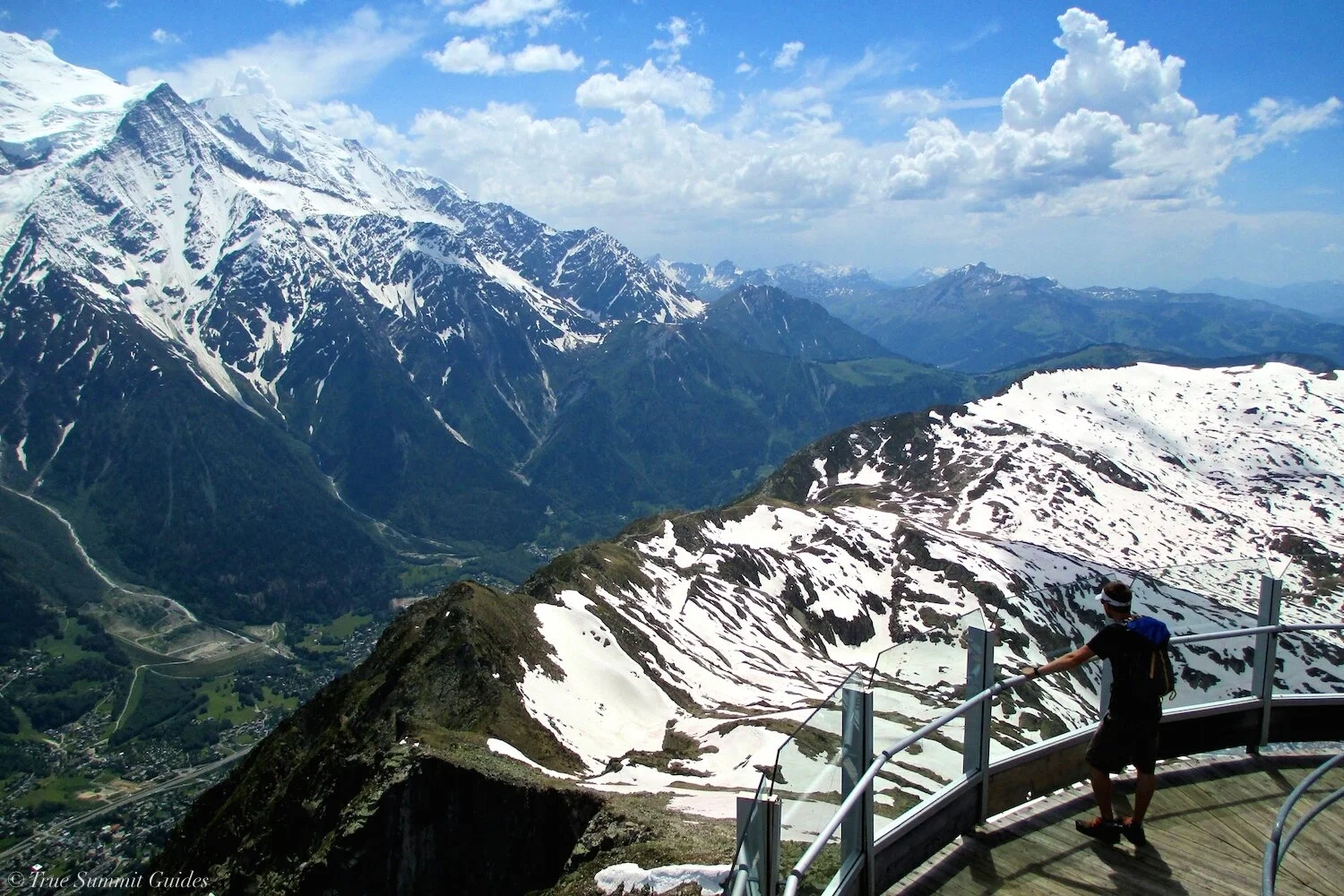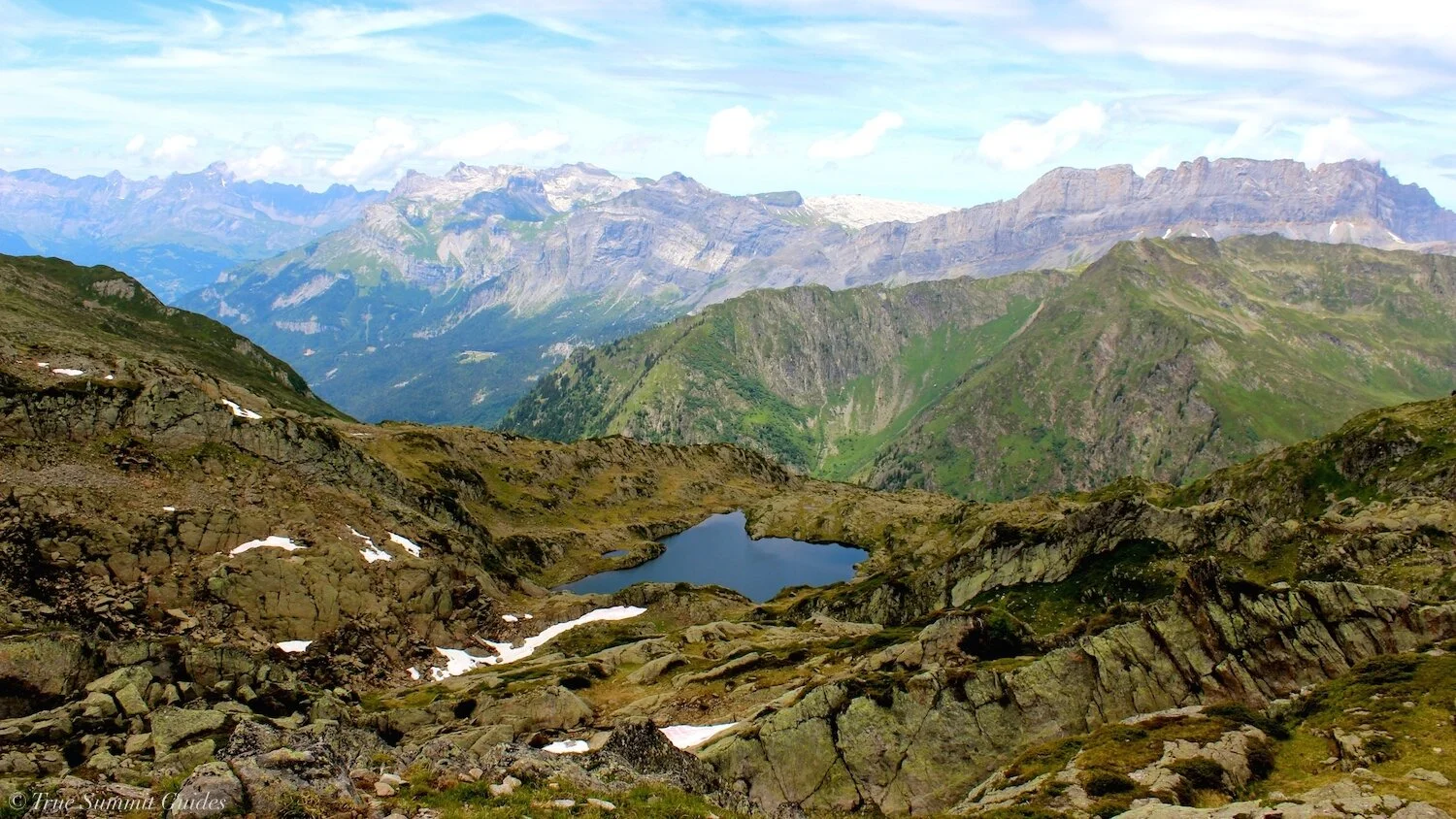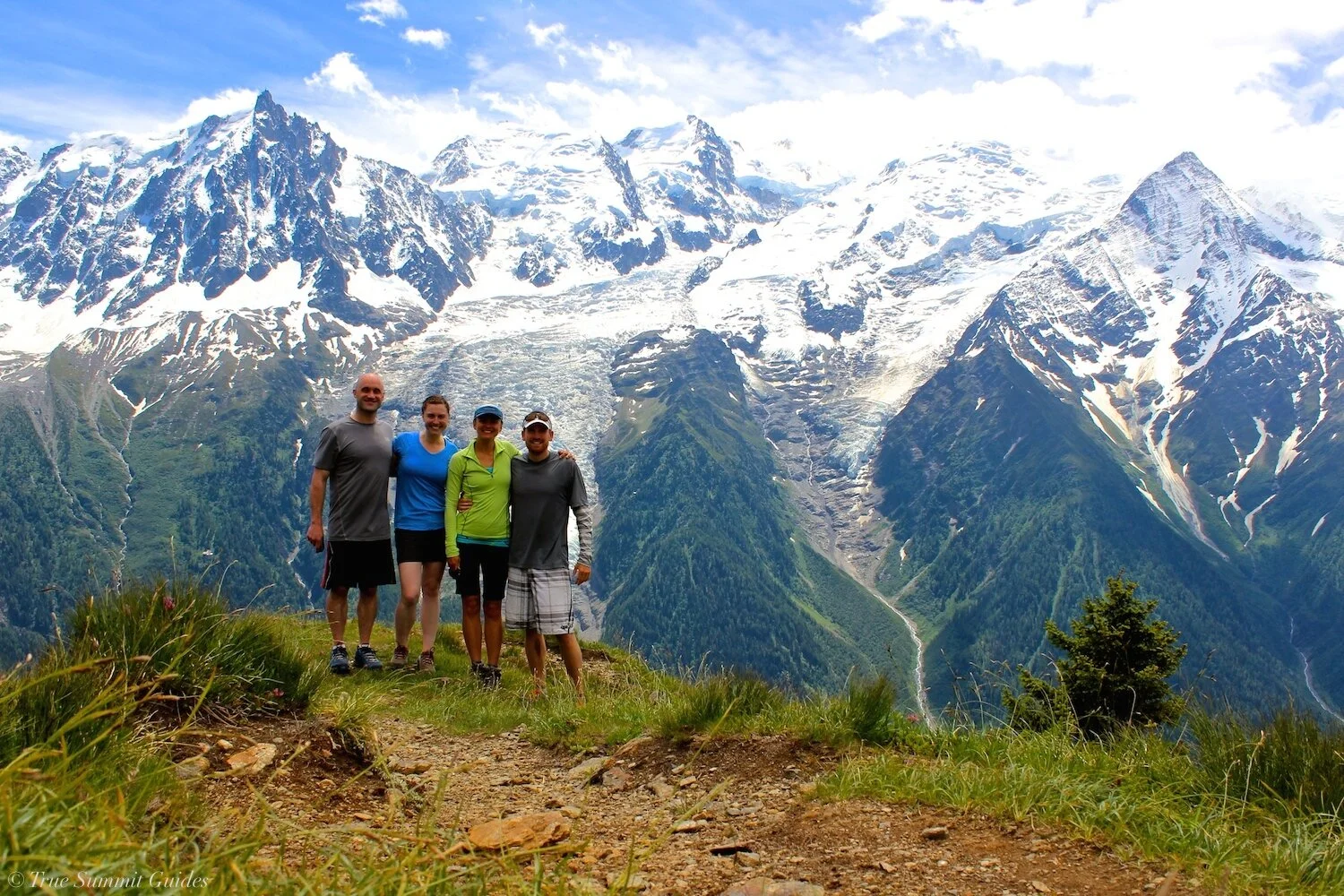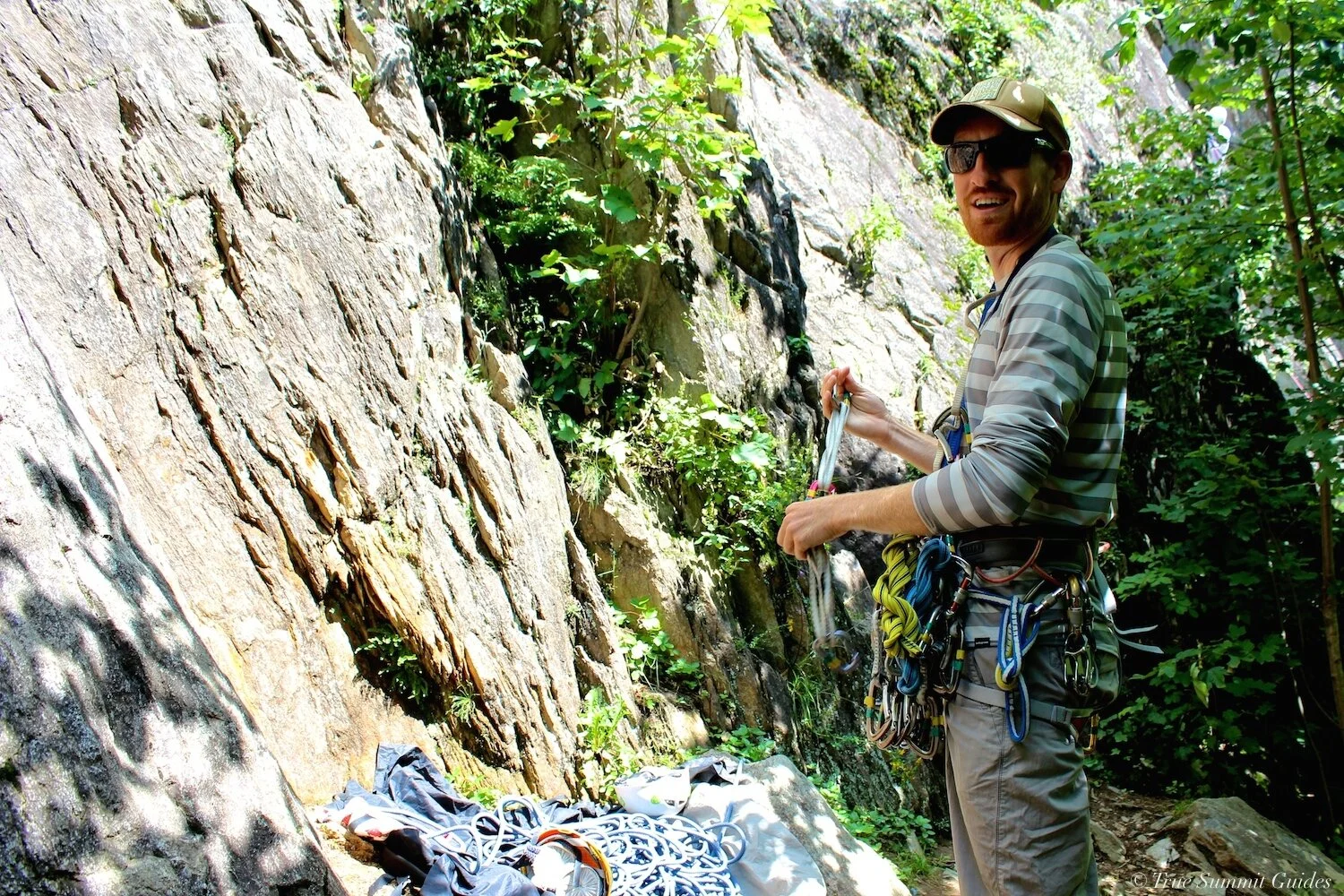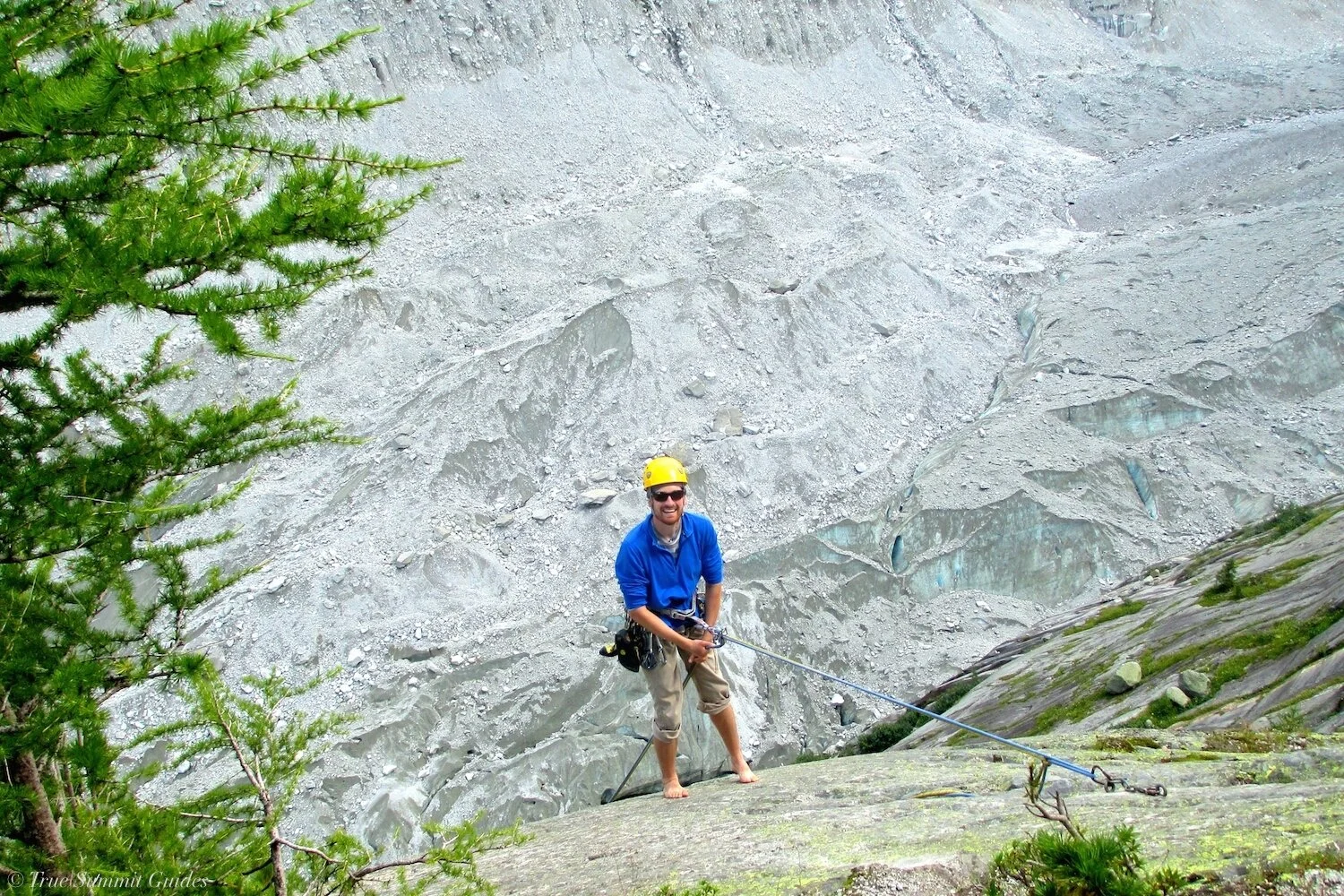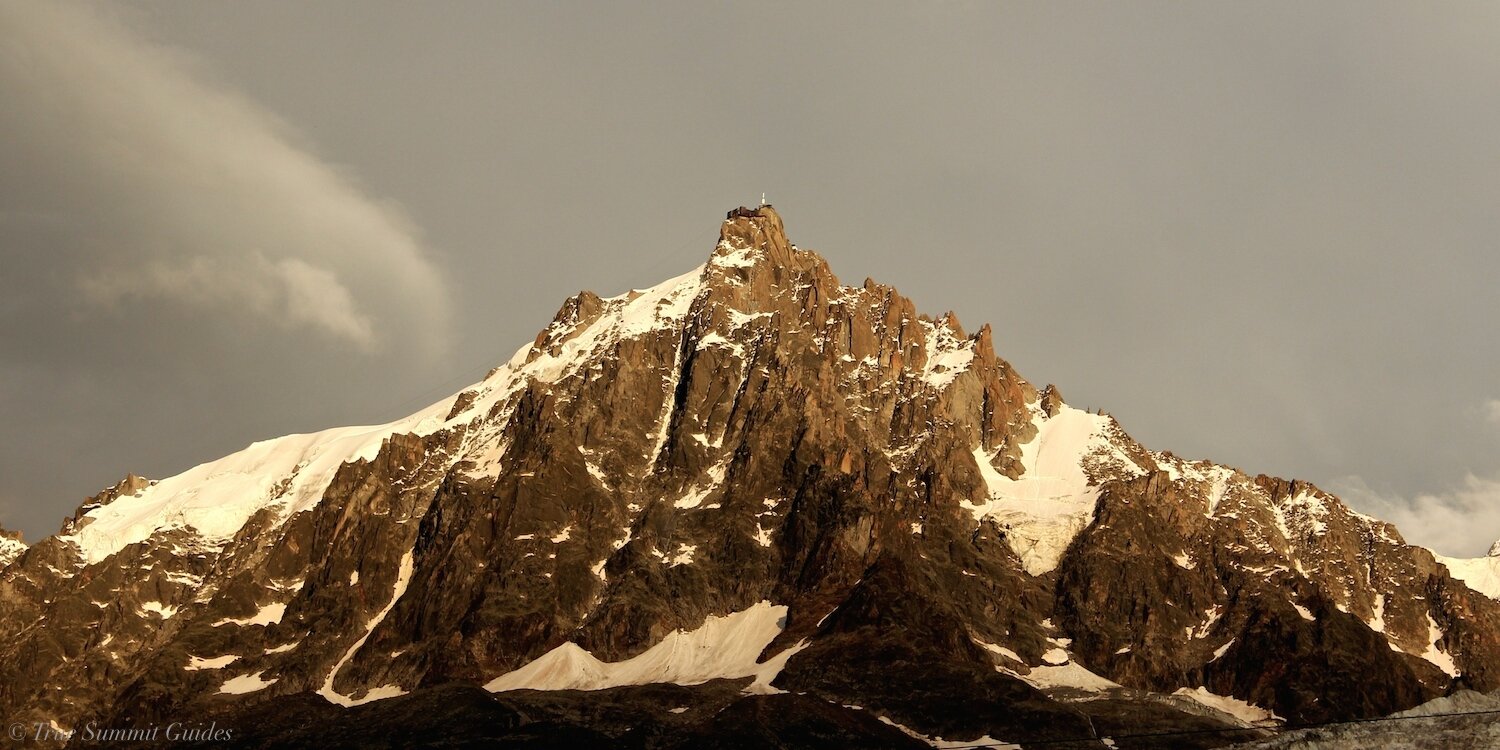French Dispatch #4: A Summer in Chamonix
Words by Dave Shuey. Photos by Noémi and Dave Shuey.
“I’m off belay!” I yell below while clipping the chains after surmounting a narrow pillar constructed of a slick, gneiss rock with lichen spread about the lesser touched spaces. With my personal anchor tethering me to the top of this miniature summit, just a stone’s throw away from families picnicking on the grassy expanse below, I turn around and gaze up towards the massive and glistening glaciated peaks only a few kilometers from where I hang. When I think of glaciers, I imagine the great Alaskan ranges, accessible only by clever bush pilots and requiring miles upon miles of trekking to reach them. Yet in the beautiful Chamonix Valley, with the simple purchase of a ticket, you can walk amongst these ice giants just minutes after setting down your morning espresso at the café and catching a gondola to the summit. For amateur and professional climbers alike, the accessibility of this extreme alpine environment, with a fairly minimal level of commitment, is what separates the Alps from the rest of the world’s great ranges. From cragging on the valley floor to alpine objectives of the Mont Blanc massif and Aiguilles Rouges, our plan of a summer spent in Chamonix is filled with much ambition, and the psych is high.
Below the sweeping terrain of the Glacier des Bossons, we established our summertime home in the back corner of the Camping des Écureuils campground. (Although named Squirrel Camp, conveniently located next door to Marmot Camp, we saw no such sightings of either animal below timberline.) We arrived on the second of June, well before the imminent summer season rush of tourists, to enjoy a few weeks of relatively mellow surroundings. In hindsight, the half empty campground and slow stream of people strolling down the streets was something to be cherished, and would soon become a distant memory to the sardines-in-a-can feeling of July and August. Nevertheless, the sun was shining and birds were chirping and Noémi and I quickly saw to getting after it!
With little in the way of camp furnishings compared to those car camping around us, we had to get a bit creative with our backpacking style materials. It is amazing the things that people bring camping with them; inside enormous tents and well furnished trailers, we saw stand up lamps, wooden dressers and desks, microwaves, and hardwood flooring, just to name a few. With some misshapen pieces of scrap wood that I found in the campground, and metal brackets with screws from the grocery store, I constructed a miniature kitchen table by the neolithic method of hammering in screws with a rock. Next up was the development of a makeshift fort utilizing parachute cord, wood scraps and a trailer cover tarp. With the basic human needs of food and shelter fulfilled, day one proved to be a great success with the minimalist creation of a fine, pinewood furniture set that would make IKEA proud.
The town of Chamonix truly has it all. It brings together a mix between old school mountaineering and skiing, modern city schools, apartments and fitness clubs, as well as posh designer clothing shops. At a single glance it is impossible not to notice the clear differences between the people who gravitate to this bustling mountain village. On a five minute stroll down its main street, you’ll pass by trail runners in bright lycra tights, well dressed couples window shopping, and alpinists just off the slopes, tromping down the street with full packs. I think that is part of why I love this city so much. Fancy-pants Chanel wearing ladies and ice ax toting dirtbags can be seen sitting on nearby benches and nobody seems to think this combination odd.
Another advantage for athletic-minded individuals are the high-end gear shops catering to everything adventure. Snell Sports and Intersport offer top-notch gadgets at great prices for skiing, climbing and trail running; whereas Patagonia, The North Face and Icebreaker supply all the apparel you could dream of to keep you cozy in the mountains. A reasonable climbing shop in California might offer a couple of options for ice axes, while between two neighboring shops in Chamonix you can grab, swing and debate between dozens of models. In the grocery store a man once asked me if there were any good gear shops in town; I almost didn’t know how to respond.
Having arrived in the beginning of June, we were fortunate enough to explore the town during the mellow shoulder season between ski season and summer. We would have most of June with the streets fairly mellow, in stark contrast to what we had been expecting based off horror stories we had heard of overpopulation and tourism. Come mid-July through August, even the side streets were packed. The best time of day we found to get errands done was around 12:30, when everyone would flock to the terraced restaurants, leaving the streets more or less deserted. While the flow of visitors may have moved well past the city’s equilibrium point, it is hard to be upset by the overwhelming quantity of tourists. I found comfort in the fact that families were bringing their kids to an outdoor wonderland for their annual summer vacations. Children can frolic in the open spaces, ride bikes, hike hills, take rock climbing classes or even a ropes course. This surely beats Disneyland any day.
To have made it this far in the article without mentioning the elephant in my head provides a glimpse of the optimism that I clung to this summer. For a year prior to our trip to France, Chamonix and all its glory was of paramount excitement for me. With so much potential for rock, snow and ice climbing, we planned to maximize the season and climb everything we possibly could. We would arrive, suit up and conquer! All year we trained hard to prepare for the toll this adventure living would take on our mortal bodies. Yet, one week into our summer in Chamonix, the rain came. And it never left. Perhaps I have been spoiled by living my entire adult life among the coastal beaches of Southern California, and was simply not prepared for a bit of rain. Of course I expected some rain in the Alps. However, the quantity of cats and dogs that fell from the sky, day after day after day, would have made a born-and-raised Seattleite weary of its relentless dominance.
As it turns out, upon further investigation with locals, we were lucky enough to spend our first visit to the alpine capital of the world during one of the rainiest summers on record. An older couple told us that in their last twenty years of vacationing every summer in Chamonix, they had never experienced weather as poor as this year. Fantastic.
This made our rock climbing pursuits rather challenging and severely limited the number of days we were able to get out on the rock. It would pour one day, then the next might be clear, but it probably wouldn’t be enough to actually dry the rock before the sky water fell again. We got cragging around the valley whenever the weather allowed, but were forced to spend most of our time hiking the slopes on either side of the valley. This did help us to maintain excellent physical shape in preparation for the Tour du Mont Blanc and Chamonix to Zermatt Walker’s Haute Route we had planned. Many climbers are not big hikers, but luckily we enjoy both and could make the most of the rainy season presented to us.
The lengthy yet narrow valley stretches from Les Houches at the south towards La Tour at the north, with Les Bossons, Chamonix, La Praz and Argentiere scattered in between. Along the west and east edges run excellently maintained trails connecting each of the bordering communities. These relatively flat paths are ideal for walking and running in the summer and cross-country skiing during winter. Straying any bit from these trails will quickly lead to a steep ascent, either towards the crest of the Aiguille Rouges flanking the west side of the valley, or the tremendous Mont Blanc and Aiguilles des Chamonix to the east. For the hiker or trail runner looking to bag some elevation, the proximity of the slopes to the towns is simply surreal. Within five minutes of leaving camp, we had access to trails with steep inclines perfect for getting outstanding views of the region, while giving our thighs as much as they could handle.
Gazing up towards the Aiguille Rouge from Chamonix’s centre ville, the rocky peak of Le Brévent immediately attracts the eye to its spectacular skyline. The summer and wintertime popularity of Brévent can not be overstated due to the massive, dual gondolas shuttling people from the valley floor to the summit in mere minutes. But as this was only the first week of June, the cables were not yet in operation and the only way to the top was via old fashioned, manual hiking.
We were spoiled the first few days after our arrival with hot, sunny weather that we didn’t realize wasn’t going to last. With around ninety-degree weather and the sun shining, we packed our day packs and headed out for our first hike to Brévent. The hiking was fairly steep, but after a couple hours of elevation gain, the temperature started to drop and a comfortable breeze picked up as we emerged above timberline. With the trees growing sparse around 2000 meters, the mountainside emerged with rolling fields of multi-colored wildflowers such as the bright pink Alpenrose. We soon approached the grassy hillsides and outstanding picnic location of Bel-Lachat, before making our way to the final, rocky portion of the hike. All signs of color quickly vanished, replaced with an expanse of loose rock and boulders, still covered with an early-season blanket of snow and ice.
The warmth of the sun on my back was quickly forgotten as I carefully placed my shoes on the snow covered rocks that supposedly formed our trail. Although still warm enough to hike in shorts and a t-shirt, I would have appreciated knee-high gaiters as I post-holed through the snow, ice creeping down the ankles of my old and only marginally Gore-Texed shoes. We had certainly found more snow than we were expecting. The sights, however, were well worth every misstep; the rolling ridge of the Aiguille Rouge was covered with a layer of white as far as we could see. Down the other side, Brévent Lake was still partially frozen, offering a unique perspective most summertime tourists don’t get to witness, as the land begins to thaw and emerge from its winter hibernation.
We passed an older gentlemen and his granddaughter (who had been smart enough to bring gaiters) making their way back down the mountain, warning us of a good deal of snow at the summit. Regardless of the language barrier between us and the challenges that lie ahead, the smiles on their faces clearly displayed the joy they had achieved during their hike amongst the raw elements. As it turns out, the pair would be the only other people we would see for the rest of our hike. We had been given the gift of relative solitude by being adventurous enough to explore the snow ridge at 2500 meters. As we meandered through snowfields, rock piles and summer runoff, we gradually approached the summit. It proved an eery scene arriving at the upper station of the gondola during off-season. In just a few weeks, once the lifts re-opened, this now tranquil haven would be transformed and trampled by thousands of stiletto wearing, poodle-toting tourists enjoying the high mountain restaurant and crêperie stand. But now, in our moments alone, we shared the sights of the stunning, glaciated peaks across the valley including the Aiguille du Midi, Aiguilles des Drus, the Dome du Gôuter and even the little sunny dome of Mont Blanc herself peaking up from the back. Aside from the family of Chamois strolling the ridge below us, Noémi and I had the whole summit to ourselves.
With some sinister mid-afternoon clouds approaching, we walked off the back of the summit towards the Col de Brévent on the northern flank. We had planned on traversing the peak with our descent towards the large plateau of Plan Praz, 500 meters below the summit, instead of repeating our approach back to Bel-Lachat. This would provide a bit more spice than we had intended however. Protected by the summit block itself, the northern slopes leading to Plan Praz were blocked from the warming summer sun, and huge snow fields still covered the trail. With a pair a skis, we could have descended along the curving road in a matter of minutes, but with only hiking shoes and trekking poles, we were in for a bit more than we had bargained for. With one pole long for balance and one shortened to act as an ice ax if we took a tumble, we began slowly navigating the snow fields.
About two-thirds of the way down I looked back to find that the approaching clouds, looking ever so thunderous, were looming a bit too close for comfort. Still well above timberline, I yelled up to Noémi a dozen meters behind and we started booking it down the slippery slopes. With the tempest approaching quickly, we bolted at first touch of solid ground without pausing to take in the vistas from Plan Praz, and took off down the switchbacks towards the town. Luckily, we made it to the safety of the trees before the storm began to take hold and were well out of harm’s way. After catching our breath and laughing about our quick retreat, we strolled slowly back to camp after an incredible twelve mile hike through forest, alpine meadows, rocky terrain and snow slopes.
We would be fortunate to partake in a repeat of the same path almost one month later in early July when my childhood friend Laurel and her boyfriend Colin joined us for a few days in Chamonix. Having already done the hike ourselves, we knew it would provide breathtaking views of both the alps and the valley below to entertain our guests. The trail to the meadows of Bel-Lachat saw little change, but the stretch towards Brévent could not have been more different. Instead of a snow-covered ridge with a half-frozen lake below, upon bending the curve in the trail, all we found was dry rock and the calm green water of a summer time lake. We hiked along at a much quicker pace than our previous snowy path had allowed, shocked at this extreme change in scenery. After only a month of warming, the entire ridgeline had been transformed. Now there were dry, obvious trails and a bounty of other hikers sharing the views.
If this lack of snow on the approach seemed shocking, it was the spectacle at the lift station on the summit that I truly couldn’t believe. There were people everywhere! Our once tranquil summit could now out-populate many small mountain villages. The previously boarded up crêperie was now serving overpriced treats to tourists in lounge chairs, and the restaurant was packed with tables on the terrace overlooking the mountains. The view of the massif and valley were the same as before, yet I found myself distracted by the throngs of tourists and their kooky portrait photography. The summer tourist season had most definitely arrived.
Another of the more memorable hikes we enjoyed took place on the Mont Blanc side of the valley just below the sweeping Glacier des Bossons. With our campground directly across the valley from this tremendous glacier, every day we gazed up to its crevassed surface and steep, often calving edges. In the still quiet of evening, we would often hear massive pops and bangs as the ice broke apart, causing rocks to dislodge from the mountain and cascade down the slopes, leaving a chill coursing through your body. We hiked up passed the suburban dwellings below the slopes and followed trails to a huge opening below the glacier, where numerous streams flowed from the meltwater that would eventually form the various legs of the river below. An awesome feeling consumes you as you gaze up beneath the white ice with striking shades of blue in its cavernous pockets. The perspective of being so close to an actively flowing glacier is simply awesome.
The trail continues up the mountain side past a couple chalets and snack shacks, or buvettes, until it cuts back towards the gully. Situated well above the terminus of the glacier, a belvedere of rock provides a remarkable view of the ice field, looking down on it from above. If you are willing to put in a little time hiking towards those less popular sites without gondola access, you will surely be rewarded for your efforts. We sat on the edge of the rock with only a couple other people and could appreciate the environment on all sides without distraction. A thickly forested slope lay to our right, the sweeping glacier to the left and the pyramidal rock faces constructing the colossal Aiguille du Midi lingered just above us. We had found a true mountain paradise.
In mid July the annual Chamonix Yoga Festival was in town. Although typically a paid, multi-day course, they were offering a few free classes that we hoped to take advantage of. Yet being the alpine capital of the world, this would not be the run-of-the-mill, sweaty studio environment the average yogi is used to. Our class would be taught at the plateau of Plan Praz, 2000 meters up, and coined “Yoga at Altitude”. With the unlikely prospect of clear weather forecasted, we packed up our yoga mats, (aka our sleeping pads) and began the steady hike upwards. The class would take place immediately after the drop off for the gondola that connects the mid-mountain site with the valley, but again we chose to hike. We continued up the switchbacked trails as the environment shifted from thick, green ferns, to sparsely scattered trees, to rock and alpine meadows. After about two hours and a few thousand feet of elevation, we found ourselves at the best situated yoga studio possible. Joined by a few dozen others, we breathed in the fresh mountain air while stretching and meditating with the Aiguilles des Chamonix on clear display before us. Wood floor, heated yoga studios certainly have their advantages, yet a ten mile hike with ninety minutes of yoga in the Alps was pretty cool too.
Prior to our arrival to the valley, I had imagined climbing on rock some five days per week, with a mentality of total domination. Unfortunately, thanks to the relentless sky fall, I spent exponentially more time stuck in the little wooden box which served as the campground’s picnic room than I did ascending or even touching rock. It was overall fairly devastating, knowing how much excellent rock was available all around without enough good weather to truly take advantage of it. One can only do so many pushups and hang from the rafters so long without climbing to lose your edge, and I could feel myself getting weaker. Sure, my endurance and trail strength had reached new heights, but the strength I had worked so hard to gain by climbing all spring was diminishing. Although in such a place of inspiration, it was hard not to get a bit down about the conditions while developing cabin fever.
In spite of all this, the mornings we woke up to clearing skies and the sun beginning to peer through offered great relief. We still had to wait until afternoon to allow the warmth to dry off the rocks, but we would at least be able to get our climb on. Although not the most ideal of places during the mid-summer tourist rush, the busy valley crag of Les Gaillands offers a decent amount of rock with the most minimal approach. A sprawling lawn near the center of town makes way for a tower of darkened gneiss rock with a tremendously relaxed feel about it. Families bring blankets, picnics, dogs and plenty of children to partake in numerous easy to moderate routes along the cliff’s spiky face. The Echelle area along with the Petit and Grand Gaillands make up the three central towers near the lawn. They are the closest and busiest walls, typically littered with climbers of all ages and abilities, any time of the day. Luckily, we managed to check out this area in early June before the bus loads arrived.
The Grand Gaillands contains a number of short three-pitch routes up its face to about seventy meters high. We dabbled with a few such as Le Piller de la Plaque with the Directe finish (5.10c) and L’arête Intégrale (5.10b). The major downfall of this region is that due to the blocky nature of the cliff, routes will contain an obnoxiously easy start leading to the difficult money portion in the middle, followed by more easy scrambling to the top. To add a little fun on one such route, I lead up with the plan to skip as many bolts as I felt safe to do so, turning the whole tower into a single seventy meter pitch. It added a bit of a challenge, especially at a point in the upper third while I was faced with a tricky and balancy 5.10c sequence with sixty meters of meandering rope drag tugging at my waist.
The Echelle area mostly contains easier routes but also features a couple fun roof problems, like Le Toit Direct (5.10c) on its left side. The Petit Gaillands section has a number of good two-pitch routes up the middle, like Le Piller Rouge (5.10b), with a handful of tricky more technical routes around the righthand corner. Le Centrale (5.10a) proved an entertaining route with a mix of careful balance moves and a full reach “hope this works” dynamic move toward the top.
To escape the crowds a bit, just around the corner up the hill from the Grand Gaillands, a few more sub-sectors provide plenty of moderately difficult routes with far less novices controlling the scene. The Forestiers sector was a great place to spend a sunny day, surrounded by trees and comforting shade. Numerous 5.9-10 routes cover the heavily featured wall, including a few fun slab problems up the center. One of the left most climbs in the Frendo area features a superb arête with a few committing moves to wrap your mind around, called simply L’arête (5.10a).
With a guidebook full of sectors all along the Chamonix valley, we were disappointed to not be able to enjoy more of what the area had to offer. After reviewing the topos, I had come across a wall near the community of Coupeau, with a plethora of short but powerful routes up to 5.12 that I was hoping to work as projects throughout the season. One marginally sunny day, we decided to see what there was to see and took a hike up to the wall. With a car, this would be a simple drive uphill, with a parking lot right next to the wall. Sans car, the walk from the train station proved quite lengthy. Once we finally reached the turn off, we descended a little trail towards the bottom of the wall, only to find the whole area thickly covered with trees. With little sunlight actually reaching the wall, it had not had a chance to dry out and with evidence of moss and spiderwebs, it was clear the routes had seen little recent traffic. Bummer.
After retreating back down the road to the valley, we decided to head out towards another crag which was more exposed to sunlight, and thus hopefully more dry. The town of Vallorcine lies on the northern side of the valley from Chamonix and features a large cliff with numerous classic routes and easy accessibility from the valley floor. We hopped back aboard the trusty Mont Blanc Express and scooted along the valley for the twenty minute ride to Vallorcine. At the end of the line, we grabbed our packs and stepped down from the train only to realize that just outside the shelter of the station’s roofed platform, it was pouring rain. By the time we got back to Chamonix, the weather had followed and we nixed our climbing hopes once more. Bummer again.
Chamonix is world-famous for its gondolas and tramways, delivering loads of both tourists and adventurers up the steep slopes, providing access without lengthy approaches. With such great access we could climb any piece of rock in a few hours and ride the cable back to the valley after rappelling, right? Yet during our three month stay in this alpine wonderland, we neglected to take a single gondola, chairlift or cog-train. Perhaps the simple explanation is clearest in that gondola ticket prices are not in cahoots with a dirtbag budget, but I think there’s more to it than that. Ascending mountains by foot, riding long highway stretches by bike, or paddling amongst islands via kayak all promote the great and perhaps lost art of human power. There is something to be said about commencing an adventure at the beginning, still in the valley, instead of halfway up. For Noémi and I, the hiking approach to a climbing objective is all apart of the climbing experience. It requires a long day, often starting at dawn and not returning to camp until past dark, yet those are the days that I find truly rewarding.
A cog-train prepares to leave the station for its ascent of the hillside as we pass by with packs full of climbing gear. The cabin of each car is packed with tourists of all ages, eyes glued to the windows to see what lies around the approaching curve. We pass alongside the train by foot, feeling a bit jealous of their effort-free approach. Our fellow travelers will arrive above the expansive Mer de Glace glacier in a mere fifteen minutes. Our goal is to reach the same spot after hiking nearly two hours at a steady incline and with approach packs. The jealousy soon subsides as we realize that we are hardly alone on this beautiful sunny morning, hiking through a mountainside forest. A summer time visit to Chamonix should certainly include the hike up to this glacier-carved gorge, and for climbers, the multi-pitch routes up the glacier’s cliffs are incredible.
At first inspection, it almost seems as if there is more dirt making up the Mer de Glace than actual ice. Yet as you gaze closer into the curving gully of rock, you realize that the entire floor of the gorge is actually a tremendously thick glacier, and simply covered with dirt along its lower stretches. The glacier makes a sweeping curve from the right before disappearing towards its continual birthplace amongst the high peaks of the massif. The glorious double peak of the Aiguille des Drus forces its dominance of the region as it towers up into the low-hanging clouds just a few kilometers to the north. To say that the sights are well worth the approach hike would be a gross understatement.
Our objective for the day, beyond simply gaping at the scene displayed before us, was to check out the steep Montenvers slabs above the glacier. These rock slabs remain modern evidence of the past volume and movement of the Mer de Glace, as it carved and polished the rock while both descending and receding along the trough of the valley. We are reminded of our time spent at the Gorges du Verdon as we prepare to rappel into the unknown with the hopes of climbing back out again. I chose a six-pitch 5.9 route called Josiane for our afternoon’s exploration. The glacier has of course receded due to global warming, and in the last decade this route has been altered as well. Just a handful of years ago, the route actually started from the edge of glacier itself, but now this is no longer possible. It certainly makes you appreciate being able to experience a massive glacier like this in person, and to see it from the unique perspective of climbing above it perhaps makes it even more impressive.
The climbing was not especially difficult, which allowed us the opportunity to gaze around and truly appreciate the position we were in amongst the giants of the Mont Blanc massif. We swung leads up slabs and a unique mid-route column of steep yet featured rock for the next couple hours. We each placed upon ourselves a good deal of rope drag by linking pitches for a couple of 65 meter leads over moderate terrain. The last people on the rocks had topped out just as we approached, which left us the whole afternoon with the place to ourselves. Alone in this unreal and awesome environment, we could hear only the sounds of the glacier as we climbed. With rockfall thundering off the cliffs behind us, ice breaking away from the edges of the glacier, and waterfalls pouring snowmelt down the mountains, these few hours of climbing were incredibly peaceful and satisfying. In the fading light of a late summer afternoon, we happily made the long hike home.
Although not the same quality as the hard granite across the valley, the Aiguilles Rouge contain a massive share of gneiss rock with enough routes to fill a climber’s lifetime. Much of the ridge is easily accessible by various gondolas and chairlifts. As mentioned before, the accessibility of the summit of Le Brévent is no exception. Although it is not the highest peak in the range, it certainly has the most aesthetically impressive sheer cliff to its summit. Many challenging lines have been put up across its exposed eastern face, following steep arêtes and dihedrals some 650 feet to the top. Our route of choice, for a first time up the face, would be the 5.10a/b classic Voie Frison-Roche.
Most people ride the gondola to the summit and hike back down to reach the bottom of the face. We thought it would be rad day to start at the valley, hike the approach to the base of the wall, climb the face to the summit and then hike back to the valley. With a fairly early start, we hiked passed the lower gondola station as people were starting to line up for the cable. We saw a few climbers with gear and knew we wouldn’t be the first to arrive at the route. We slowly made our way up the steep mountainside, passing Plan Praz to continue up the snaking dirt road towards the wall. This classic climb is one of the most popular at Brévent. Not surprisingly, the route was jam-packed with three parties in front of us waiting to start up the first pitch. Fortunately, we were hardly in a rush and enjoyed a moment to unwind and eat some snacks after our long approach.
The climb was worth the wait and right off the bat offered some fun, steep climbing up a pillar for the first pitch. Noémi would take the next two leads over varied and featured rock, meandering a bit but following a good line of consistent difficulty. As expected, the fourth pitch turned out to be the crux with a steep section of face climbing to tire you out, before an athletic wide-crack. Stemming and a few horizontal cracks helped me up the difficult section and I made it to the ledge above, breathing hard. A fourth-class scramble around the corner led to the most perfect dihedral corner system I’ve personally had the joy of climbing. I had planned on leading this pitch as well, but after the previous battle I let Noémi have a go on the 5.9 corner. The pitch was a true gem and only could have been better if all the bolts were removed and led traditionally, as there were plenty of excellent opportunities for gear placements. After I topped out to Noémi’s belay, we got to watch a wing-suit BASE jumper swan dive off the summit railing just fifty feet away. As we made the return hike back to camp, we couldn’t help but be stubbornly proud of the human-powered style to which we enjoyed our day out in the mountains.
Although we weren’t able to climb as much as we had hoped in Chamonix, we managed to get in a couple of long multi-pitches and several days of sunny cragging, not to mention over 400 miles of hiking and 110,000 feet of elevation gain. After three months of living out of a tent, and nearly a year of backpacking around Europe, I think it’s safe to say that our perspectives have changed. We have tried to live very simply and inexpensively, making do with what we have. If some scraps of wood can build us a shoddy table, why bother buying some new plastic thing we’ll throw away in two months? Trying to make our gear last as long as physically possible, we have lost three pairs of shoes and, most unfortunately, our tent as sacrifice to the adventure gods. We were very sad to see it go, but it withheld extreme abuse these past few months and put up a valiant fight. We have also gotten really good at making quick and healthy meals, with tons of veggies and protein, using only one small pot and burner. After a summer of camping, it almost feels strange to be inside now; we often find ourselves leaving the windows open at night and going for long walks when we’ve been in a house too long. I will certainly never take California sunshine for granted again; my eyes have been opened to the fickleness of the Alps, and when blessed with a weather window, one must enjoy it to its maximum potential.
In less than a week, we will board a plane and return to our home in San Diego. Having come full circle with a short return to Paris, it is impossible to not reflect upon our year abroad as our French Dispatches come to a close. Almost a year ago, Noémi began acquainting me with her French family who I have come to love, as well as shown me around the ever-bustling city of Paris where she was born. We explored together the forest and great, sandstone boulders of Fontainebleau during the cold, crisp atmosphere of late autumn. We headed north and withstood frigid winter rains as we strolled the cities of Amsterdam, Lille and London. In Catalonia, Spain, I experienced for the first time the simple joy of scouting out foreign rock towers and cliffs while immersing myself amongst the people and culture of the small villages that surround them. The towers of Montserrat and the cliffs of Siurana firmly left their mark within my memory. In the south of France I was welcomed graciously with open arms by people new to me, and over the course of spring they became my own family as well. I shall never forget the fun we had traveling throughout the south in a rented van, while searching out places like the Gorges du Verdon, Céüse, Orpierre, Buoux and Sainte-Victoire. Our summer spent in Chamonix is still fresh in mind, and I have no doubt of our return well before those memories begin to fade. Throughout the past year I have learned much about myself while Noémi and I have continued to grow together. As we return home, I hope to retain this sense of adventure for years to come, while continuously encouraging others to follow suit. Carpe Diem my friends!

